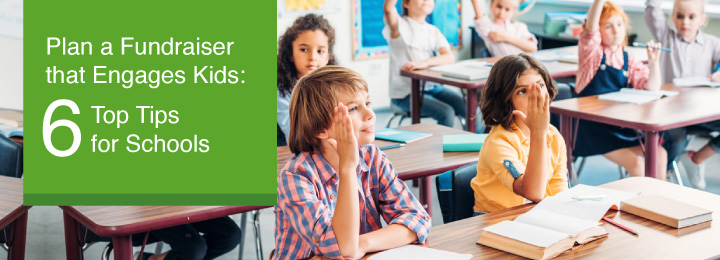Plan a Fundraiser that Engages Kids: 6 Top Tips for Schools
Your school undoubtedly enjoys supporting the programs and activities that your students love, and you should be able to continue to do so. But as an educator or member of the PTA, your time is limited. You have many tasks vying for your attention and it can be difficult to balance everything and still perform each task well.
School fundraising should not be another source of stress in your life. Fundraising for all of your kids and teens’ favorite programs can be fun and engaging for you, your students, and your community. However, to avoid becoming overwhelmed with stress as you organize the fundraiser, utilize an effective event fundraising software.
To cultivate a fundraiser that kids will want to participate in and promote, you should:
- Plan a fun event.
- Stay organized.
- Encourage personalization.
- Allow healthy competition.
- Offer incentives.
- Make it shareable.
If you follow these 6 best tips for school fundraising, you will be blasting through your fundraising goals in no time—and getting your kids involved in the fundraising process. So, without further ado, let’s start learning how to create the best and most engaging fundraiser your school has ever seen!
1. Plan a fun event.
The best way to guarantee your students actually want to get involved in your fundraiser is to make it fun and simple. It is entirely possible that the goal of raising money is not enough to get the students to engage with the fundraiser.
Depending on the age of the kids, they may not quite grasp the importance of money in making sure the programs you provide can still be offered year after year.
To ensure the students value the fundraiser, try planning your fundraiser around a fun event. To get some inspiration for fundraising ideas, click here.
A Fun Run or Jog-a-thon is an excellent example of a fun and easy event that’s well-suited for school-aged children.
The concept of a Fun Run or Jog-a-thon is simple. The student should recruit friends, adults, and family to pledge money for each unit of distance that they run or donate a lump sum for the entire distance. This could look like:
- Uncle Joe pledges $3 for every lap ran by Timmy S.
- Janet pledges $2 for every half mile ran by Ellie H.
- Charlie donates $50 to Louis’ Fun Run fund.
An effective walk-a-thon allows for the kids to hang out with their friends and stay active while supporting their school.
2. Stay organized.
One of the hardest parts of organizing and promoting a large-scale school fundraiser is making sure all of your data stays organized. You may be unfamiliar with fundraising techniques and strategies—and that’s completely normal!
To stay organized and properly manage the information you gather from your Fun Run or Jog-a-thon you should employ a Fun Run/Jog-a-thon fundraising software, like 99Pledges.
The best software will track and manage the pledges made to your Fun Run or Jog-a-thon so that you don’t have to! Yes, you heard that correctly. You will never have to sit with a calculator adding up the money that each pledgor owes to your child’s fundraising page.
This technology will allow you to load each child’s information into the program and create a custom-made, individualized fundraising page for supporters to donate or pledge money to.
If you want to get kids and teens involved invested in your fundraising efforts, you need to have an organized system that can easily integrate students into its process.
3. Encourage personalization.
While you are all fundraising for the same end result, your fundraiser participants may have many reasons for becoming involved. Some people might participate because they are passionate about the cause or the program that your event benefits. Meanwhile, others may want to compete for incentives or simply participate in your fun event.
Whatever the reason for their participation, you should encourage students to personalize their fundraising page to entice more supporters.
With the right software tool, each student will be able to fundraise separately for a common goal. While some fields on their unique page may be consistent throughout all the supporters, such as the:
- School name or program
- Description of the fundraiser
- Per participant goal
- Date of the fundraiser
The students or their parents should still have the option to write a fundraising letter that offers an impassioned appeal for donations and pledges that will be more likely to draw in friends and family supporters.
This fundraising letter should:
- Describe the fundraising event in their own words.
- Explain what the fundraiser benefits.
- Convey the student’s reason for participating.
- Provide donation information.
- Thank the supporter in advance.
It is not likely that friends and family members will donate or pledge money simply because it is a good cause. They want the emotional appeal—they want to donate and pledge money because it is something the student is passionate about.
Feel free to encourage your students to make this fundraiser their own. This will not only cause the students to become more invested in the outcome of the fundraiser, but it will also boost your fundraising revenue!
4. Allow healthy competition.
One of the benefits of your PTA hosting a participant-based fundraising event is that the work is divided up among a wide range of people. While we know it can be difficult to motivate such a wide group of kids, make sure you don’t underestimate the power of healthy competition.
Friendly competition among friends has the potential to greatly enhance your fundraising revenue and encourage students to work hard to gain supporters.
The students should be able to have some sort of visual that represents how much each student is fundraising. A good software tool will display top donations that can serve as motivation for students to seek out additional support for their pages.
If you choose to do a walk-a-thon, or any variation of the event-a-thon, it is easy for the students to see how hard their peers are working. The student may be more inclined to walk further or read more or hit more baseballs if they can see how well other participants are doing.
While good, old-fashioned competition is one of the best motivators in fundraising among kids and teens, you must remember to provide some incentives that will further encourage the students to put effort into the campaign.
5. Offer incentives.
If you want to modify your fundraising strategy to maximize the number of students who are meaningfully engaging with your fundraiser, you should offer incentives to participants. Kids and teens love free stuff and added perks— but then again, who doesn’t?
To make competition a sustainable motivator and to help students stay excited about your fundraiser, you must give them a light at the end of the tunnel. They need something to look forward to and something to latch onto as they fundraise.
Don’t worry. The incentives don’t need to be elaborate or expensive, just something that will appeal to the kids and teens participating in your fundraising event.
Potential incentives you may want to offer include:
- A pizza party for the classes with the highest participation rates.
- Giving a percentage of the total earnings to the class who raises the most money.
- Allowing the class to allocate the money they earn above their goal to a project of their own.
Depending on the age of your students, they may respond better to different incentives. Make sure you offer incentives that you know your students will love and want to achieve.
An easy way to incentivize all of your students at once is to provide fundraising team t-shirts. These can be custom made based on class, grade, or school depending on the size of your fundraiser. The kids will love the free merch and be excited to wear it, which will, in turn, promote the fundraiser.
To see how you can increase excitement in your fundraiser with a tangible incentive, check out Bonfire’s custom school shirts.
6. Make it shareable.
The best tactic to include in your fundraising plan when hosting a school fundraiser that kids and teens will want to be a part of is to make it shareable on social media. Instagram, Facebook, Twitter and so many more social media platforms have taken over how people communicate with one another and share news that is important to them.
Depending on the age of your students they may have their own social media accounts or, at the very least, it is likely their parents have accounts. Enabling students to share the fundraiser with remote friends and family members and to engage with the fundraiser on their own terms will make it more likely that the students actually want to participate.
You will be able to reach more people and encourage the students to promote their own fundraising page if the event-a-thon software that you use allows mobile sharing of personalized pages, your students and their parents are sure to want to spread the word about the school fundraiser.
Your school fundraiser should be easy and fun for everyone involved—student, teachers, parents, and supporters alike! With the right software, your walk-a-thon or other exciting fundraising events can engage your students and increase your fundraising revenue.
This post was contributed by Brad Dowhaniuk.
Brad Dowhaniuk is the co-founder of 99Pledges, which provides schools and teams with an easy-to-use, web-based fundraising solution to manage and drive success in Fun Runs, jog-a-thons, baseball hit-a-thons, and much more.











